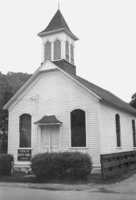 | Back to e-WV
| Back to e-WV
 The West Virginia Encyclopedia
The West Virginia Encyclopedia
 | Back to e-WV
| Back to e-WV
 The West Virginia Encyclopedia
The West Virginia Encyclopedia

The African Zion Baptist Church, a center of worship for Malden’s Black community, organized as a formal congregation in 1852, and the present building was built two decades later. Known then as the Kanawha Salines, Malden held West Virginia’s largest concentration of slaves, numbering more than 1,500 and tending the town’s booming saltworks. Gen. Lewis Ruffner gave the land, money, and materials for construction of the one-room church building. Services began there in 1872 and continued well into the 20th century. African Zion is the state’s oldest Black Baptist church and is recognized as the mother church for all of West Virginia’s Black Baptists.
Its most famous congregant was educator Booker T. Washington, who had come as a boy to the Kanawha Valley when freed from slavery. After graduation from Hampton Normal Institute in Virginia in 1876, Washington returned to live in Malden, teaching Sunday School at African Zion. Washington clerked and married his first wife, Fannie Smith, at the church in 1881 before leaving for Tuskegee. Until his death in 1915, Washington kept his membership in the church.
African Zion’s architectural style is typical for the Southern church: simple, unadorned, even spartan. Essentially unchanged since the 1870s, the wood-frame church is a rectangular, front gable design with two tall windows with segmental arch hoods on each side. A short steeple crowns the roof above the front door. Special ceremonies still occur in the sanctuary.
Today, the church is part of an African-American heritage nucleus in the middle of Malden. ‘‘Fresh Start Salt Village,’’ a replica of the postbellum salt-worker’s living conditions, features a reproduction of Washington’s cabin (the original sat approximately 50 yards to the northwest), a combination schoolhouse-church, and a museum. The African Zion Baptist Church was named to the National Register of Historic Places in 1974.
Read the National Register nomination.
Written by Garrett C. Jeter
Bickley, Ancella R., ed. Our Mount Vernons: Historic Register Listings of Sites Significant to the Black History of West Virginia. Huntington: Carter G. Woodson Memorial Foundation & Drinko Academy, 1997.
Cohen, Stan & Richard Andre. Kanawha County Images. Charleston: Pictorial Histories Publishing Company & Kanawha County Bicentennial, 1987.
Comstock, Jim, ed. West Virginia Heritage Encyclopedia vol. 1. Richwood: Jim Comstock, 1976.